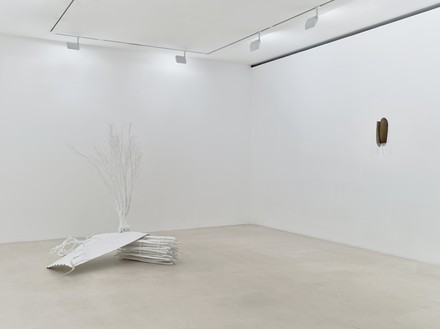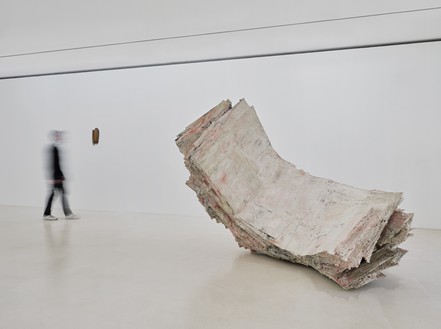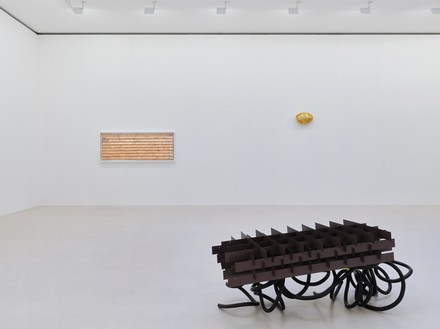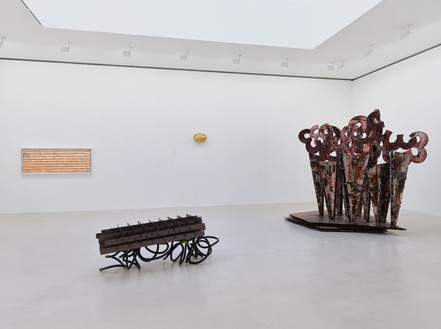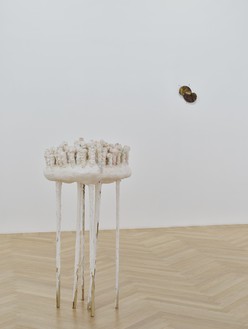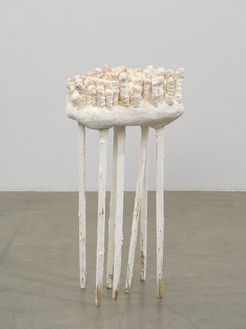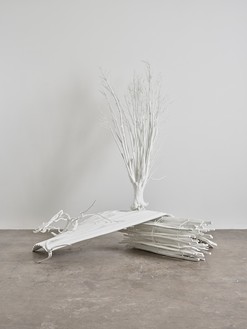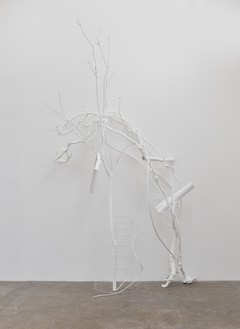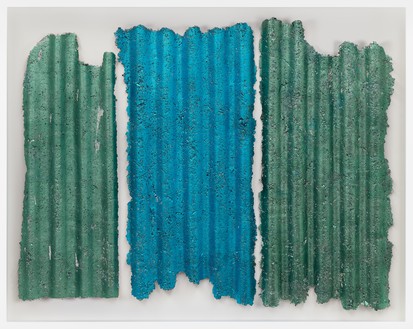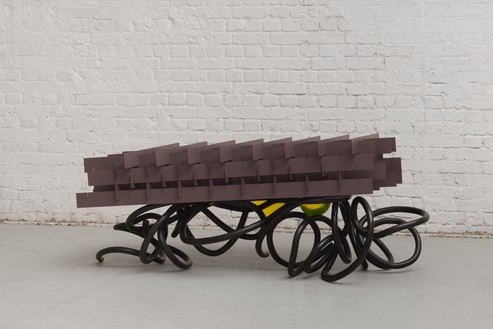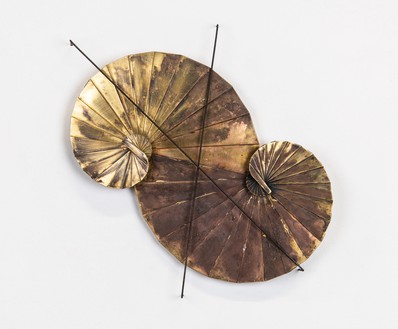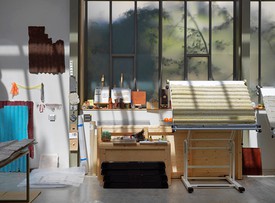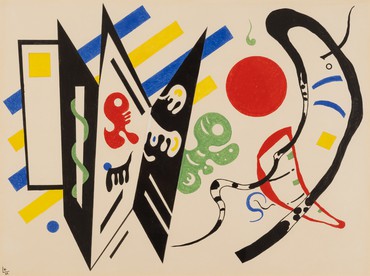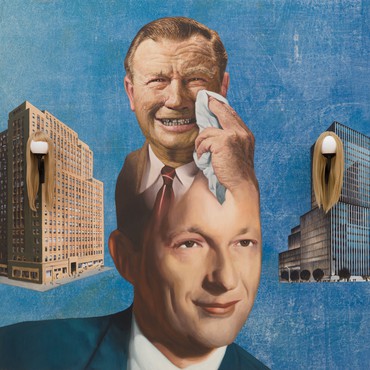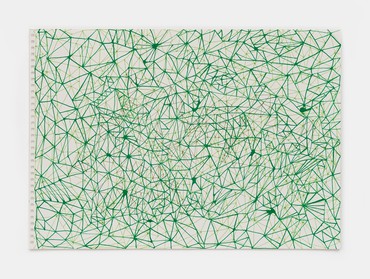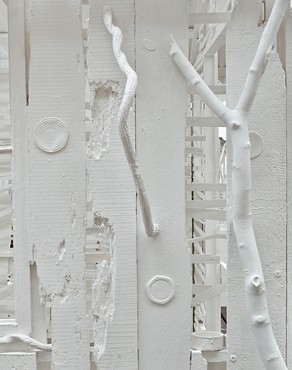About
When shall we three meet again?
In thunder, lightning, or in rain?
When the hurly-burly’s done,
When the battle’s lost and won
—William Shakespeare
Gagosian Paris is pleased to present an exhibition of sculpture by Phyllida Barlow, Rachel Whiteread, and Alison Wilding. Hurly-burly realizes the artists’ long-standing desire to collaborate on an exhibition.
Hurly-burly features several works by each artist, providing viewers with a rare opportunity to compare their diverse but interconnected approaches. It is presented not as a conversation between the works themselves, but rather as a record of an ongoing exchange between the personalities and visions behind them. None of the artists saw or discussed what the others were making during the run-up to the exhibition.
The exhibition’s title makes playful reference to another famous alliance, in the opening scene of Shakespeare’s Macbeth. It also alludes to the ever-changing character of the art world that Barlow, Whiteread, and Wilding have observed and participated in over the course of their careers. Wilding first met Barlow in London in 1969 when the latter was teaching at Chelsea College of Art, and both met Whiteread in 1982 at Brighton Polytechnic, where they were her tutors. Barlow and Wilding left Brighton to teach at London’s Slade School of Fine Art, and Whiteread followed them there to study sculpture and worked as an assistant to both. The three have remained friends throughout the forty years since.
Quand nous réunirons-nous toutes trois ?
Serait-ce par le tonnerre, les éclairs ou
la pluie ?
Quand le bacchanal aura cessé,
Quand la bataille sera gagnée et perdue.
—William Shakespeare
Gagosian Paris a le plaisir de présenter une exposition de sculptures de Phyllida Barlow, Rachel Whiteread et Alison Wilding. Hurly-burly est le résultat d’un désir de longue date des artistes de réaliser une exposition collaborative.
Hurly-burly présente plusieurs œuvres de chaque artiste, proposant aux visiteurs la rare occasion de comparer leurs approches diverses mais toutefois, interconnectées. L’exposition n’est pas conçue tel un dialogue entre les œuvres elles-mêmes, mais plutôt comme le constat dun échange permanent entre les personnalités et leurs visions. Les artistes n’ont ni vu les œuvres ni discuté de de celles-ci en amont de l’exposition.
Le titre de l’exposition fait référence de manière ludique à une autre alliance célèbre, la scène d’ouverture de Macbeth de Shakespeare. Il fait également allusion au caractère changeant du monde de l’art que Barlow, Whiteread et Wilding ont observé et soutenu au cours de leurs carrières. Wilding et Barlow se sont connues à Londres en 1969, alors que cette dernière enseignait au Chelsea College of Art, toutes deux ont ensuite rencontré Whiteread en 1982 à Brighton Polytechnic, où elles étaient ses professeures. Barlow et Wilding ont quitté Brighton afin d’enseigner à la Slade School of Fine Art de Londres, où Whiteread leur a succédé pour y étudier la sculpture et fut leur assistante. Les trois artistes sont restées amies depuis ces quarante dernières années.
Barlow utilise habituellement des matériaux du quotidien et industriels tels que le ciment, le contreplaqué et le polystyrène, produisant des structures anti-monumentales souvent peintes de couleurs vives et dans lesquelles les méthodes de construction sont laissées stratégiquement visibles. Dans les œuvres à grande échelle, tel que modernsculpture (2022), l’artiste joue avec l’équilibre, la masse et le volume, testant et réorientant notre négociation du monde physique, tandis que des œuvres plus petites, tel que TORSO (1986–89), englobent des allusions corporelles ironiques (cette dernière est également l’une de ses plus anciennes sculptures existantes).
Dans ses sculptures récentes, Whiteread s’oriente vers l’utilisation de formes plus ouvertes et naturelles que ses œuvres précédentes moulées, mais conserve une sensibilité aigue pour les détails des objets. Untitled (Crease) (2021–22) et Untitled (Climber) (2022) sont réalisées à partir de branches et de lattes de bois trouvées et liées entre elles grâce à d’autres matériaux. Enduites de peinture ménagère opaque, les structures d’un blanc fantomatique font allusion à des récits inachevés ou interrompus tout en évoquant une présence corporelle fugace. Dans des œuvres murales plus petites, comme Untitled (Lemon and Blue) (2020–22) et Untitled (Blue, Blue, Blue) (2022), Whiteread revient au processus de moulage, conférant à des surfaces industrielles familières des couleurs et des finitions inattendues.
Wilding, pour sa part, combine une grande variété de techniques et de formes, aboutissant à des sculptures abstraites éclectiques centrées sur le contraste, la dissimulation et la dissemblance des matériaux. Elle rejette toute hiérarchie traditionnelle des matériaux, qu’ils soient industriels ou organiques, récupérés ou réaffectés, et son choix découle souvent de ce qui lui est disponible à un moment donné. X (2018) est une élégante double boucle segmentée en laiton patiné ressemblant à un coquillage ou à un escalier en spirale, alors que le sommet en pointe du tube en cuivre de Pointing (2021) le transforme en une couronne archétypale étendue, s’élevant d’une base en hexagramme en azobé.
Un catalogue comprenant des essais de l’historienne et critique d’art Briony Fer et de l’auteure et journaliste Louisa Buck sera publié à l’occasion de l’exposition.
Share
Artists
Phyllida Barlow
Rachel Whiteread
Alison Wilding

Rachel Whiteread: … And the Animals Were Sold
An installation by Rachel Whiteread in the Palazzo della Ragione, Bergamo, Italy, commissioned by Galleria d’Arte Moderna e Contemporanea di Bergamo and cocurated by Lorenzo Giusti and Sara Fumagalli, opened in June of 2023 and ran into the fall. Conceived in relation to the city, the architecture of the site, and the history of the region, it comprised sixty sculptures made with local types of stone. Fumagalli writes on the exhibition and architect Luca Cipelletti speaks with Whiteread.
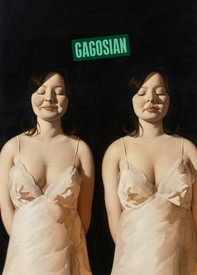
Now available
Gagosian Quarterly Winter 2022
The Winter 2022 issue of Gagosian Quarterly is now available, featuring Anna Weyant’s Two Eileens (2022) on its cover.
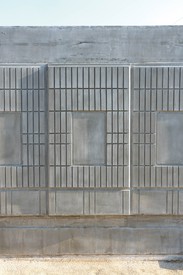
Rachel Whiteread: Shy Sculpture
On the occasion of the unveiling of her latest Shy Sculpture, in Kunisaki, Japan, Rachel Whiteread joined curator and art historian Fumio Nanjo for a conversation about this ongoing series.They address the origins of these sculptures and the details of each project.
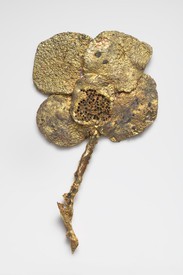
Augurs of Spring
As spring approaches in the Northern Hemisphere, Sydney Stutterheim reflects on the iconography and symbolism of the season in art both past and present.
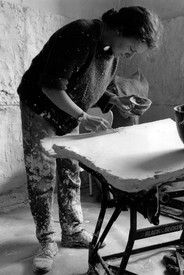
In Conversation
Tom Eccles and Kiki Smith on Rachel Whiteread
On the occasion of Artist Spotlight: Rachel Whiteread, curator Tom Eccles and artist Kiki Smith speak about the work of Rachel Whiteread through the lens of their personal friendships with her. They discuss her public projects from the early 1990s to the present, the relationship between drawing and sculpture in her practice, and the way her works reveal the memories embedded in familiar everyday objects.
In Conversation
Rachel Whiteread and Ann Gallagher
Rachel Whiteread speaks to Ann Gallagher about a new group of resin sculptures for an exhibition at Gagosian in London. They discuss the works’ emphasis on surface texture, light, and reflection.


